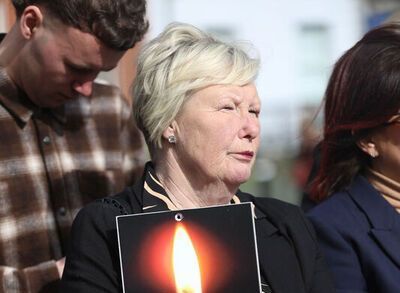Tom Phelan on a recent visit to his native Mountmellick, Co. Laois.
PHOTO BY PATRICIA PHELAN
By Tom Phelan
Learning the responses for the Latin Mass was a time of warmth, love, and delight: warmth, because our group of eight potential altar boys sat outside on the steps of the sacristy in the heat of the autumn sun; delight, because I was being let in on the mysterious priestly language that rolled exotically around the tongue; and love, because I fell in love at age 10 with the sweet voice, beautiful face, and slender soft fingers of Sister Carmel, the nun who was instructing us. No other part of her body was visible, and anyway I was too young to be interested in what was beneath her habit.
With her back against the black iron railing, Sister Carmel intoned and eight voices eagerly repeated. The trace of a bemused smile put sparkles in Sister Carmel’s eyes. Perhaps she was not used to dealing with boys of our age, or perhaps she was trying to keep from looking up our short trousers, our legs sprawled and spread; in those days only oul gerls wore underwear.
“Quia tu es, Deus, fortitudo mea…” The lovely lips laid the words out sweetly into the air. Sister Carmel smelled like distant roses.
On the warm steps we almost sang the words she placed before us. When we had memorized the first page of responses, she recited the priest’s lines, emphasizing the last syllable to wave us into our part.
“Introibo ad altare Dei! I will go unto the altar of God.”
“Ad Deum qui laetificat juventutem meam! To God who gives joy to my youth.”
The possession of the magical Latin words, the informality of the sunny setting, the feelings that Sister Carmel aroused, the mesmerizing sound of a group chanting a lesson by rote – all these created joyous moments. Before the instruction was over I was looking forward to the next one.
“Boys! Now that you are going to be serving mass you must always behave better than ordinary lads. You must give example by doing your homework and not getting into fights in school.”
“Boys! You must always have a handkerchief in your pocket--no more using your sleeves.”
‘Boys! You may not serve Mass with dirt under your nails or your hair not combed.” I wondered who she was talking about until on the way home I noticed my filthy fingernails on the bike’s handlebars.
As the lessons progressed during that autumn, not even the bully Mickey Siney’s schoolyard jeering—“Cluck, cluck! Here comes the holy water hen!”—muddied my feelings of specialness, of being one of the chosen.
With the responses firmly embedded in our memories, we learned to genuflect in unison in the Altar Boys’ Sacristy: back straight, prayerful hands at chest, thumbs crossed, right knee landing beside left shoe, back straight when resuming standing position. If a boy lost his balance or bent over on the way down as if he had been kicked in the balls, we did the exercise over.
Learning to bow in one fluid movement was not easy.
“Boys! Bend your hips slightly, bring your shoulders forward slightly, and bow your head.”
While I was inwardly gloating about the contortions of some of the others, Sister Carmel said, “It’s hips, shoulders, and head, Tom Phelan! You are doing shoulders, hips, and head, and if you try to bow that way you’ll kill yourself.”
Our first entrance from the Priests’ Sacristy into the sanctuary was held in suspense as the nun tested, for the last time, each boy’s Latin, genuflecting, and bowing. When she examined our nails, she bent down to my ear and whispered, “You have the fingernails of a priest.” Even at age 10, I was being prodded toward the seminary.
“Boys! What kind of shoes must you wear to serve Mass?”
“Black plimsolls, Sister.”
“You carry the plimsolls from home to the sacristy, and then put them on here. Why must you wear plimsolls when you are serving Mass?”
‘So we won’t be making noise like an oul farmer with hobnailed boots, Sister.”
“And…?”
‘So we won’t squash cow dung into the pictures in the floor, Sister.’
“Mosaics!”
“Mosaics, Sister.”
“What time must you be in the Altar Boys’ Sacristy?”
“Ten minutes before Mass starts, Sister.”
At last Sister Carmel opened the door of the Priest’s Sacristy, and we got our first glimpse of the nave stretching away into the gloaming distance, hues from the stained-glass windows hanging in the still air. I could see off to the Toberbeg Corner, where men from that townland, kneeling on their caps with one knee and resting their leaning bodies on the other, congregated for Sunday Mass. There, they gossiped and sometimes sold calves to each other, spitting on their hands before sealing the deal with a slapping of palms.
“Boys! You must be absolutely silent when you step onto the sanctuary floor.”
In our socks we paraded like two rows of chicks following their black mother hen until we came to a stop in front of the enormous marble altar. Standing so close to it, I gasped at its height, its intricate carvings, and the angels and saints in their niches. The white of it!
In my excitement I did not see that the rear wall of the altar was undressed stone scarred with chisel marks. Nor did I notice then that in the space between the altar and the back wall of the church were stored the props used during the yearly liturgical cycle: the tall filigreed holder for the Easter candle, the folded Christmas crib, the purple penitential cloths of Lent, the six black candles used at funerals. In their untidiness, their symbolism was lost until nothing remained but pieces of wood and metal and cloth. This was the dark, glamourless backstage of any theatre that is kept out of sight lest it spoil the illusions spun by the actors on the other side of the curtain. But I was seeing the church through the golden nimbus of youth and inexperience where there was no squalor.
Acting as both priest and conductor, Sister Carmel took us through the strict rubrical dance of assisting the celebrant of the mass. Every move and every step was choreographed.
“Boys! You must move so quietly, so smoothly, that only the priest is seen. You must become invisible to the people in the church.”
We learned when to genuflect, when to stand, when to move the missal from one side of the altar to the other, when to bring the water and wine to the priest, when to strike the gong, when to bring water to the priest to purify his fingers, and when to get the paten to hold under communicants’ chins. This last job turned out to be the best: sometimes a person’s false teeth fell out, and to be holding the paten when the dentures came in for a landing gave an aura of specialness to the altar boy who caught them. And in the sacristy after Mass, we would imitate the distorted features of certain parishioners when they stuck out their tongues for communion: the Tooth, Glass Eye, No Nose, Snake Tongue, and Tonsils. Their facial gyrations became legend among generations of altar boys.
Eventually Sister Carmel was satisfied perfection had been reached, and with our heads full of liturgical Latin, we were altar boys at long last.
On the days when it was my turn to serve Mass, I pedaled with delight along sun-brightened, dusty Strahard Lane that in fine summer weather was as different from a wet, water-filled potholed and mucky lane as good health is from the flu. On dewy mornings, when the tiny dewdrops glittered in the slanting sun, so many cobwebs on bushes and grass and weeds lit up that it seemed the whole world was tied down under millions of strings of diamonds. Not only that, the illuminated dewdrops became pearls strewn on the world by a happy and well-pleased God.
But in my four years as an altar boy, I never once had the privilege of catching anyone’s false teeth.
© 2017 by Glanvil Enterprises, Ltd. Tom Phelan’s latest novel is “Lies the Mushroom Pickers Told.” For more about him, go to tomphelan.net.










